Re Ian Bremmer 'Could third-party candidates upend the 2024 US election?' 3 April The current political movement in the USA…
Tibet
Written by Diana Thebaud Nicholson // October 30, 2015 // Asia, Geopolitics // 2 Comments
See also China, Beijing Olympics and Olympic Protest Prime
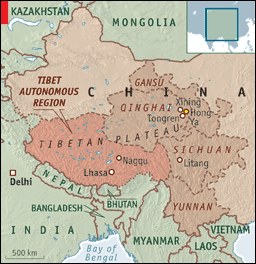 During Tibet’s early history it was an independent and often powerful state, but from the 13th century, when it submitted to Mongol rule, until modern times, it has endured long periods of either Chinese control, Chinese influence, or effective autonomy.
During Tibet’s early history it was an independent and often powerful state, but from the 13th century, when it submitted to Mongol rule, until modern times, it has endured long periods of either Chinese control, Chinese influence, or effective autonomy.
Tibet has become the focus of world attention after violent protests against Chinese rule.
It has long captured the West’s imagination as the site of a mystical Utopia.
Geographically dramatic and remote, it has an average altitude of 13,000ft (4,000m) above sea level and is popularly referred to as “the roof of the world”.
It is isolated not only geographically, but also diplomatically. China enforced a long-held claim to Tibet in 1950, and it was subsequently incorporated into Chinese territory.
Tibet’s spiritual leader, the Dalai Lama, fled to Dharamsala in northern India, where his supporters have set up a government in exile. Meanwhile Tibet itself is rapidly changing, as increasing numbers of Han Chinese arrive in search of work. (More on BBC)
Tibet: The Forgotten Refugee Crisis
Tibetan sovereign culture, religion, history, and language are being systematically and deliberately erased in what the Dalai Lama has called a ‘cultural genocide’ at the hands of China’s Communist party.
(Epoch Times) The Majnu Ka Tilla Tibetan refugee colony in New Delhi is a chaotic neighborhood of narrow alleys and shanty concrete structures packed into a thin strip of land between National Highway 9 and the Yamuna River.
The refugee colony was founded in the 1960s to consolidate Tibetan refugee communities around India’s capital into one location. Today, about 3,000 Tibetans live in Majnu Ka Tilla.
Scattered throughout India and Nepal, Tibetan refugee colonies like Sonamling have become time capsules of Tibetan culture prior to the 1950 Chinese invasion.
“I went back to Tibet in 1991 for two months,” Topgyal Tsering, 47, said during an interview at the Tibetan government in exile’s offices in Sonamling. “There were many changes. Tibetan culture was disappearing very fast. There were no more yaks, and no more dzos plowing the fields. People no longer wear the traditional clothes, and in some places it is forbidden to speak the Tibetan language.”
The need to preserve their culture, coupled with an unshakeable belief that Tibet will one day regain its independence, has left the Tibetan refugee community in limbo. “Tibetans can’t integrate into India because if they do, their culture will disappear,” Tsering said…. With China stamping out Tibetan culture within Tibet, Tsering said refugee communities have a special responsibility to preserve their exiled nation’s culture, religion, and language.
… “The border between India and China is almost completely sealed,” Rinchen said. “It’s almost impossible to get out. China is spending a lot of money to guard this border and keep Tibetans from fleeing. This is telling. People don’t risk their lives to escape a country where they are happy and have a good life.”
Rinchen is second in command of the Tibetan government in exile’s Department of Security. The department has a broad set of responsibilities and is equivalent to a fusion of the CIA, Secret Service, and FBI for the exiled Tibetan government. Approximately 100 staffers and agents working for the department assist the Indian government with providing security for the Dalai Lama. They also hunt for Chinese spies in Dharamshala, defend Tibetan government computers against Chinese cyberattacks (which are frequent) and debrief recently escaped Tibetan refugees about conditions inside Tibet.
Rinchen said the security department’s debriefings of refugees paint a picture of pervasive human rights violations inside Tibet, as well as simmering resentment against Chinese rule that has not abated or diminished after 65 years.
2013
9 May
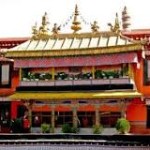 China destroys the ancient Buddhist symbol of Lhasa City in Tibet
China destroys the ancient Buddhist symbol of Lhasa City in Tibet
(CNN) Ignoring both religious freedom and the outcry of the Tibetan people, the Chinese authorities have begun demolishing the ancient capital of Lhasa, including one of the most important Buddhist sites of the city, Tibet’s holiest Jokhang Temple.
Chinese authorities are planning to destroy the ancient Buddhist capital of Lhasa, and replace it with a tourist city similar to Lijiang. “Shangri-La” in Yunnan Province. Several large-scale construction projects are underway for a number of shopping malls around the Buddhist holy temple as well as underground parking at Barkhor Street.
8 February
China cracks down on Tibet protests
Beijing arrests 70 in ethnic Tibetan areas as it steps up efforts to blame Dalai Lama for self-immolations in protest at Chinese rule
(The Guardian) China’s government says it has detained 70 people in ethnic Tibetan areas as it cracks down on self-immolation protests against Chinese rule.
Beijing has stepped up its efforts to blame the exiled Tibetan leader, the Dalai Lama, for the protests, in which nearly 100 Tibetan monks, nuns and lay people have set themselves on fire since 2009.
The harsh measures are a sign new Chinese leaders installed in November are not easing up on Tibet despite international condemnation.
2012
China clamps down on budding Tibetan revolt
(Globe & Mail) A string of mountain towns along the edge of the Tibetan Plateau that set out to mourn, rather than celebrate, the Chinese lunar new year are now under lockdown following days of clashes between Tibetan protesters and Chinese police that left several people dead.
Tens of thousands of residents of the towns of Serthar and Luhuo – and more in the surrounding Tibetan-populated western corner of Sichuan province – have been effectively cut off from the outside world after the violence. Telephone and Internet services to the region have apparently been severed, and checkpoints have been set up along the roads to control who gets in and out.
2011
Dalai Lama mocks authorities in message to Archbishop Tutu
(The Independent) The Dalai Lama said that China was built on lies, poked fun at the South African government and pretended to be a demon in a video call to Archbishop Emeritus Desmond Tutu’s birthday celebrations in South Africa.
S.African diplomacy reeling from Dalai Lama debacle
(Reuters) – Africa’s biggest economy has already shown that it casts a tiny foreign policy shadow and South Africa’s most recent diplomatic debacle — over a visa for the Dalai Lama — has likely further diminished its stature by showing how easily it can be bullied.
9 October
Dalai Lama visa blocked ‘over South African trade fears with China’
South Africa refused to give the Dalai Lama a visa to visit for Desmond Tutu’s birthday because the foreign ministry feared his trip would jeopardise trade ties with China, according to reports.
4 October
South Africa’s Cowardly Lion
(Foreign Policy Magazine) From kissing Qaddafi to stiffing the Dalai Lama, what’s happened to Nelson Mandela’s Rainbow Nation?
20 August
China, Tibet and the Dalai Lama — Lamas at loggerheads
Three articles look at China and religion. First, a war of attrition over Tibet; next, China v the Vatican; third, a Chinese project at the Buddha’s birthplace
(The Economist) China has its eyes on a complex struggle that will play out after the death of the current 76-year-old Dalai Lama, who lives in exile in India. With the endorsement of its own Panchen Lama, China wants to choose a successor to the current Dalai Lama and seek to control him. Hence it is believed to be keeping another young man, who was the Dalai Lama’s choice as Panchen Lama 16 years ago, incommunicado in an unknown location. China fears that Tibetan exiles will appoint their own Dalai Lama and it does not want any authoritative Tibetan figure to show him support. Both China and the exiles have recently been stepping up preparations for a coming dispute.
17 August
The Myth of Socialist Paradise
By LOBSANG SANGAY
Dharamsala, India — THREE years ago, Tibetans from Lhasa to Lithang rose up against Chinese rule in Tibet.
Earlier this week, a Tibetan monk set himself on fire — the second self-immolation this year, and a testament to China’s continuing repression and Tibetans’ continued resistance.
We do not encourage protests, but it is our sacred duty to support our voiceless and courageous compatriots.
In 1950, when the Chinese Army first came to Tibet, they promised a socialist paradise for Tibetans.
After more than 60 years of misrule, Tibet is no socialist paradise.
There is not socialism but colonialism; there is no paradise, only tragedy.
Some Tibetans helped build roads to Tibet from China and were paid in silver coins by polite and respectful Chinese soldiers.
However, once the roads were built in early 1950s, tanks encircled strategic urban areas, trucks headed straight to the mineral-rich mountains, and Chinese workers arrived later to exploit and mine billions of dollars worth of gold, copper and uranium.
Overnight, it seemed, something had changed.
The polite Chinese people changed, too, and became overbearing and aggressive.
They used their guns.
Battles erupted.
There was death and destruction.
The continuing political repression, cultural assimilation, economic marginalization and environmental destruction in occupied Tibet are unacceptable.
The new railway line from Beijing to Lhasa is bringing more heavy equipment to exploit our natural resources and more Chinese migrants, who are beginning to demographically dominate Tibet.
Today, around 70 percent of private-sector firms are owned or run by Chinese, more than 50 percent of government officials are Chinese, and approximately 40 percent of Tibetans with university and high school degrees are unemployed.
And this is made worse by Chinese officials who treat Tibet as their personal inheritance, and behave like latter-day feudal lords.
Earlier this year, several Chinese leaders visited Lhasa to celebrate 60 years of so-called peaceful liberation. But the reality is that the anniversary was observed under undeclared martial law.
Troops carried automatic machine guns as they marched through the streets of Lhasa while sharpshooters positioned themselves on rooftops.
Tourists, of course, were banned from visiting during the “celebration.”
The Tibetan political leadership is still committed to nonviolence and a peaceful resolution through dialogue. We will continue our “middle way” policy, which seeks genuine autonomy for Tibet within the People’s Republic of China, a win-win proposition for both the Tibetans and the Chinese.
China aspires to be a superpower.
It has a fast-growing economy backed by growing military power, but sadly, its moral power is lagging behind.
And moral power cannot be bought in the marketplace or forced with military might.
It has to be earned.
As long as Tibetans are reduced to second-class citizens in their own homeland, there will be resistance to Chinese rule.
Finding a lasting solution to the Tibet question, on the other hand, would improve China’s image in the eyes of the world and help protect its territorial integrity and sovereignty.
Peaceful dialogue could lead to genuine Tibetan autonomy within China.
This is a solution that would satisfy both Tibetan and Chinese interests and it would be a victory not only for the Tibetan people, but for all marginalized people around the world.
19 July
Tibet, China and America — Toward the light?
(The Economist) ON THE topic of Tibet, Xi Jinping, the man widely expected to be the next leader of the Chinese Communist Party, sounds much like his predecessors. Speaking on July 19th in the capital, Lhasa, in front of the Potala Palace, former residence of the Dalai Lamas, Tibet’s spiritual leaders, he celebrated the way Chinese rule had led Tibet “from the dark toward the light”.
In material terms, he has an obvious point. Tibet is far better-off than in 1951, when a young Dalai Lama reached a “17-point agreement” ceding Chinese sovereignty over the territory. He also has a point that, before 1951, Tibet was not some idyllic Shangri-La of tinkling temple bells, lowing conch shells and smiling people, but a highly stratified society relying on mass monasticism and serfdom.
The difficulty Mr Xi and his predecessors face, however, is that large numbers of Tibetans resent Chinese rule. Many are still loyal to the Dalai Lama, who fled into exile with some 80,000 of his followers after the crushing of an anti-Chinese uprising in 1959. Since then the region has been scarred by periodic riots, including a bloody outburst of anti-Chinese violence in Lhasa in 2008.
24 April
China’s Tibetan problem
More turbulent monks
THE open wound that is Tibetan resentment of Chinese rule refuses to heal. According to accounts seeping out of China, it has been bleeding profusely for some six weeks now at Kirti, a Tibetan monastery in Sichuan province. Kirti is in Aba prefecture, which Tibetans regard as Amdo, a part of historic Tibet.
Two Tibetans in their sixties are reported to have died after being beaten by security forces on April 21st. Their deaths came as the monastery was raided and more than 300 of its nearly 2,500 monks were detained for purposes of “legal education”.
14 March
The Dalai Lama resigns
(The Economist) This might seem untimely, given Tibet political predicament. Talks between the Chinese government and the Tibetan exiles are badly stalled. The Dalai Lama himself, though in good health, is now 75 years old. The question of his succession is perennial, and thorny, when it comes between China and the exile government. Last week, Padma Choling, the Chinese-appointed governor of Tibet, made the dumbfounding assertion that the Dalai Lama must follow the tradition of reincarnation and cannot choose his successor. Strange as it is to see the Communist Party dictating the terms of a Buddhist reincarnation, it wouldn’t be the first time China has intervened with succession of Tibetan Buddhist leaders. After the Panchen Lama, the second-highest figure in Tibetan Buddhism, died in 1989, the Dalai Lama recognised a young boy living in Tibet as his reincarnation: the “next” Panchen Lama—or the same one, as it were. China however preferred a different Tibetan boy, whom it installed as Panchen Lama on its own. The Dalai Lama’s appointee was placed under indefinite house arrest; his whereabouts remain unknown.
Dalai Lama cedes political role in Tibetan government
The Dalai Lama announced Thursday that he will no longer play a political role in the exiled government of Tibet, signaling his desire for a more democratic structure in the run-up to elections for a new prime minister. “As early as the 1960s, I have repeatedly stressed that Tibetans need a leader, elected freely by the Tibetan people, to whom I can devolve power,” he said. The New York Times (3/10), BBC (3/10)
7 March
(RCI) China has closed the Tibetan region to foreign tourists for the rest of the month of March. Travel agents say the move comes before the third anniversary of violent anti-government riots there. And the agents say they will have to wait for notification to see whether the region will be reopened in April. After anti-government riots in Lhasa in March 2008, foreign tourists were banned from travelling to the Himalayan region for more than a year. A report released by Human Rights Watch last year said Chinese security forces brutally beat and even shot dead some protesters during the 2008 unrest, and tortured many in the subsequent crackdown.
2010
China’s Money and Migrants Pour Into Tibet
Han Chinese workers, investors, merchants, teachers and soldiers are pouring into remote Tibet. After the violence that ravaged this region in 2008, China’s aim is to make Tibet wealthier — and more Chinese.
Chinese leaders see development, along with an enhanced security presence, as the key to pacifying the Buddhist region. The central government invested $3 billion in the Tibet Autonomous Region last year, a 31 percent increase over 2008. Tibet’s gross domestic product is growing at a 12 percent annual rate, faster than the robust Chinese national average.
23 July
Report Faults China in Tibet Unrest
A detailed report by Human Rights Watch says Chinese security forces violated international law in suppressing the Tibetan protests and riots of 2008 by indiscriminately beating, detaining and fatally shooting civilians in towns across the vast Tibetan plateau in western China. The report, released on Wednesday night, said security officers used disproportionate force in trying to control Tibetans, including against women, teenagers, monks and nuns.
15 July
Splittism on the roof of the world
Geneticists say Chinese and Tibetans were once one. The news appears to be welcome to neither side
(The Economist) TO DREAMERS in the West, Tibet is a Shangri-La despoiled by Chinese ruthlessness and rapacity. To China’s rulers it is a backward kind of place whose former serfs, “liberated” by the Communist army, have repaid the favour with ingratitude and even outright “splittism”. But to excited scientists, Tibet is the site of possibly the fastest case of human evolution through natural selection in the history of mankind.
1 July
Scientists Cite Fastest Case of Human Evolution
Comparing the genomes of Tibetans and Han Chinese, the majority ethnic group in China, the biologists found that at least 30 genes had undergone evolutionary change in the Tibetans as they adapted to life on the high plateau. Tibetans and Han Chinese split apart as recently as 3,000 years ago, say the biologists, a group at the Beijing Genomics Institute led by Xin Yi and Jian Wang. The report appears in Friday’s issue of Science.
24 June
Tibetan Environmentalist Receives 15-Year Sentence
Human rights advocates say the prosecution of Mr. Samdrup and his brothers are part of a worrisome crackdown on Tibetan artists, intellectuals and students, among others, that has intensified since March 2008, when rioting in Tibet stunned Chinese leaders in the midst of their preparations for the Olympics in Beijing.
24 May
Chinese engineers propose world’s biggest hydro-electric project in Tibet
Mega-dam on Yarlung Tsangpo river would save 200m tonnes of CO2 but could spark conflict over downstream water supply
Chinese hydropower lobbyists are calling for construction of the world’s biggest hydro-electric project on the upper reaches of the Brahmaputra river as part of a huge expansion of renewable power in the Himalayas.
Any step forward is likely to be controversial. Tibetans consider Metog a sacred region, and environmental activists warn against building such a huge project in a seismically active and ecologically fragile area.
“A large dam on the Tibetan plateau would amount to a major, irreversible experiment with geo-engineering,” said Peter Bosshard of International Rivers. “Blocking the Yarlung Tsangpo could devastate the fragile ecosystem of the Tibetan plateau, and would withhold the river’s sediments from the fertile floodplains of Assam in north-east India, and Bangladesh.”
17 April
After Quake, Tibetans Distrust China’s Help
Since a deadly earthquake nearly flattened this predominantly Tibetan city early Wednesday, killing at least 1,400 people, China’s leadership has treated the quake as a dual emergency — a humanitarian crisis almost three miles above sea level in remote Qinghai Province, and a fresh test of the Communist Party’s ability to keep a lid on dissent among restive Tibetans.
But despite outward signs of government largess and ethnic unity, the earthquake has exposed stubborn tensions between Beijing and Tibetans, many of whom have long struggled to maintain their autonomy and cultural identity amid a Han-dominated country.
3 April
Book review: The Struggle for Tibet by Wang Lixiong and Tsering Shakya
… our ignorance is hardly surprising. We talk a lot about the Tibet we see from the outside, but as Robert Barnett, one of a handful of western scholars who understand the country, tells us in his introduction, the voices of the Tibetan people are only heard in “snatches and fragments”.
After the country was sealed off by China in 1959 following the Lhasa rebellion and flight of the Dalai Lama, it became a “muffled, incoherent place”. The British left has always been diffident about the Tibet issue, unable to shake off the memory of our own imperial designs, and uneasy at the CIA’s role in the 1950s and 60s in the Tibetan resistance (two of the Dalai Lama’s brothers worked with them). … Both scholars warn that Tibet’s cultural and national identity has been dangerously eroded, and that China’s rushed economic development only benefits a minority.
18 February 2010
China Intensifies Tug of War With India Over Nepal, With Tibet in Shadows
Last week a Nepalese government delegation visited Beijing on a trip that underscored, once again, how China’s newfound weight in the world is altering old geopolitical equations.
As Nepal’s home minister, Bhim Rawal, met with China’s top security officials, Chinese state media reported that the two countries had agreed to cooperate on border security, while Nepal restated its commitment to preventing any “anti-China” events on its side of the border.
The reason for the deal is simple: Tibet.
Prodded by China, Nepal is now moving to close the Himalayan passages through which Tibetans have long made secret trips in and out of China, often on pilgrimages to visit the Dalai Lama in his exile in India.
15 May 2009
South Africa in Dalai Lama U-turn
(BBC) New International Relations Minister Maite Nkoana-Mashabane said Tibet’s spiritual leader could now visit whenever he wanted. The government caused an international outcry when it said it would not allow him to attend a peace conference, linked to the 2010 Football World Cup.
10 March
Even today, Tibetans in Tibet live in constant fear, and the Chinese authorities remain constantly suspicious of them. Their religion, culture, language, identity are near extinction. The Tibetan people are regarded like criminals, deserving to be put to death.
10 March
The Dalai Lama. Read the full story
Dalai Lama Harshly Condemns China
The Dalai Lama spoke in Dharamsala, India, the Himalayan hill town that is the seat of the Tibetan government in exile. Tibetans outside of China and their supporters held rallies around the world on Tuesday to mark the 50th anniversary of a failed Tibetan uprising against Chinese rule. The Chinese military crushed the rebellion, forcing the Dalai Lama to flee across the Himalayas to India. (CBC) Dalai Lama blasts ‘brutal crackdown’ in Tibet
4 March
Fearing more riots, China cracks down on Tibetans
Thousands of troops have occupied China’s Tibetan regions in an effort to suppress riots on the 50th anniversary of the failed Tibetan uprising on March 10. Fearing the worst, Chinese officials have set up outposts, searched cars and imposed a curfew in the capital of Lhasa. “The security forces are everywhere, on every corner, day and night,” one Tibetan woman said. The New York Times (3/4)
2 March
Public Talk by Dr. Tsering Shakya: Tibet 50 Years On, 1959 to 2009
26 February
The new year arrives in Tibet with the region under armed guard
This year the authorities are unusually edgy. They have mounted a pre-emptive clampdown of a severity rarely seen in recent years. Monastery towns across a wide area of the Tibetan plateau are being sealed off from visitors. In those still accessible, troops are on heightened alert to prevent any repeat of last year’s explosion of discontent. Security measures vary across the vast Tibetan-inhabited area of China, which includes parts of four provinces as well as the Tibet Autonomous Region itself. Helmeted troops bearing rifles patrol Lhasa, the Tibetan capital. Snipers lurk on rooftops near the Jokhang temple, Tibet’s holiest shrine and often a focus for protests. Foreign journalists are largely barred from Tibet. Chinese travel agencies say foreign tourists are also denied entry until late March.
1 October 2008
Armed Chinese police still occupy Lhasa six months after riots
The continued paramilitary presence in Lhasa, Tibet’s capital, suggests that Chinese officials still fear an uprising similar to the deadly protests six months ago. The Guardian, the first Western news outlet to visit the city since those riots, found that activity is bustling but religious activity has moved underground and armed police patrol the streets. The Guardian (London) (10/1)
22 June
Get On the Bus
Geoffrey York, Globe & Mail
The official press tour is one of the rituals of Communist China, as time-honored as the ceremony to raise the Chinese flag at Tiananmen Square every morning. It’s far from the ideal way to gather news.
But with Tibet still tightly sealed off from the outside world, I accepted an invitation to join a government-sponsored press tour to Lhasa this weekend, realizing it was the only way to get even a limited glimpse into this locked-down region.
17 May
Communist Party rule has been good for Tibetans in a material sense. Herdsmen now use motorcycles to round up their yaks, electricity and satellite television are common, and education is spreading. Tibetans are manifestly better off than in my previous visits, yet unhappiness is growing along with incomes.
Nicholas Kristof: The Terrified Monks
15 April
(Stratfor) Chinese Geopolitics and the Significance of Tibet
Beijing has three geopolitical imperatives:
1. Maintain internal unity so that far powers can’t weaken the ability of the central government to defend China.
2. Maintain a strong coastal defense to prevent an incursion from the Pacific.
3. Secure China’s periphery by anchoring the country’s frontiers on impassable geographical features; in other words, hold its current borders.
In short, China’s strategy is to establish an island, defend its frontiers efficiently using its geographical isolation as a force multiplier, and, above all, maintain the power of the central government over the country, preventing regionalism and factionalism.
Reason Lost in Angry Voices on Tibet
(Asia Sentinel) In the squabble between Chinese and western media, truth, as usual, is the first casualty
Never mind the Tibetans, the media war between China and the West has been so furious that editors appear to have forgotten what the protests were all about. Much as western journalists distorted Burma’s uprising last year from a plea to help the poverty-stricken into a single-minded demand for democracy, the Tibetans’ case has been hijacked by a xenophobic Xinhua on the one hand and a Free Tibet-spouting, China-doubting, western press on the other.
April 11
Gwynne Dyer: Controversial flame has never burned brightly
(New Zealand Herald) What’s actually colliding here are two irreconcilable views of the world. For almost all Chinese, the turmoil in Tibet is a threat to national unity. Only in the past century have Tibet and the Turkish-speaking, Muslim province of Sinkiang come to be seen as a necessary part of that national unity, but they are now. Chinese propaganda insists that the local people support that consensus, but it makes no difference if they don’t. They have to stay, because national unity is at stake.
For almost everybody else, China and Tibet is obviously a colonial relationship, and it’s perfectly natural for the Tibetans to seek independence. They won’t get it this time round, and they may never get it, but why would you be surprised that they try? Indeed, why wouldn’t you support them?
Foreign governments will never support Tibet’s independence, because they depend on China’s trade and they value “stability” in China above all else. Foreign individuals are under no such constraints, and the Tour of the Torch is giving them a lot of opportunities to show their feelings.
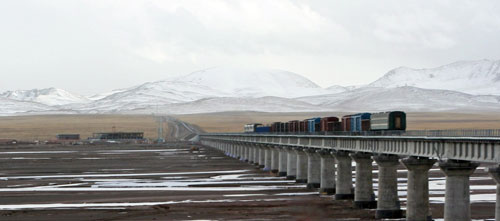
SINCE 2006 the railway line across the Tibetan plateau (above) has been carrying passengers and freight across a landscape of snow-covered peaks and tundra, antelopes and wolves. China celebrates it as one of the nation’s greatest technological feats. But some experts worry that global warming may render it useless.
The impact of warming can be seen on a road that runs parallel to the line for much of its length. Trucks bump along its cracked and undulating surface, which is being ravaged by the freezing and thawing of the tundra beneath. Since the highway was built in the 1950s, the permafrost area has been shrinking and the layer above it, which is subject to seasonal thaw, has been getting deeper. The railway is vulnerable to the same process. More
April 10
Massive Chinese investment in Tibet produces few results
(The Economist) For a leadership that has committed to the development of China’s backward western provinces, recent riots and continuing tensions in Tibet have been a huge embarrassment to say the least. The violent outbursts of hatred towards Han Chinese and Hui Muslim businesses in Lhasa have shattered the façade of stability secured at the cost of record amounts of transfer payments from Beijing and massive commercial investments in the “autonomous region”. Though the harmonious co-existence of different ethnic groups remains one of the centrepieces of state propaganda, it is now clear that rapid economic development in Tibet has bypassed the overwhelming majority of Tibetans who remain poor, disgruntled and suspicious of Beijing’s largesse.
April 1
China issues wild conspiracy claims against Dalai Lama
Chris Buckley, Reuters
BEIJING — China accused Tibetan groups on Tuesday of planning suicide attacks following last month’s riots and protests but did not answer key questions about its evidence for such allegations.
March 27
Bush calls Hu to urge Tibet talks
(BBC) US President George W Bush has urged China to begin dialogue with Tibet’s spiritual leader, the Dalai Lama. Mr Bush called his Chinese counterpart Hu Jintao to raise his concerns about the unrest and to urge him to ease access for journalists and diplomats.
Tibet: Her Pain, My Shame
Tang Danhong 唐丹鸿,(born in 1965 ) is a poet and documentary filmmaker from Chengdu, Sichuan. She has made several documentaries in and about Tibet since the 1990s. She wrote the following essay this week and published it on her own blog (hosted outside of China), partially translated by CDT:
… For more than a decade, I have frequently entered Tibet and often stayed there for a long time, traveling or working. I have met all kinds of Tibetans, from youngsters on the streets, folk artists, herders on the grasslands, voodoo doctors in mountain villages, to ordinary cadres in state agencies, street vendors in Lhasa, monks and cleaners in monasteries, artists and writers…Among those Tibetans I have met, some frankly told me that Tibet was a small country several decades ago, with its own government, religious leader, currency and military; some stay silent, with a sense of helplessness, and avoid talking with me, a Han Chinese, afraid this is an awkward subject. Some think that no matter what happened, it is an historical fact that Chinese and Tibetans had a long history of exchanges with each other, and the relationship must be carefully maintained by both sides. Some were angered by the railway project, and by those roads named “Beijing Road,” “Jiangsu Road,” “Sichuan-Tibet road,” but others accept them happily. Some say that you (Han Chinese) invest millions in Tibet but you also got what you wanted and even more; some say you invest in the development but you also destroy, and what you destroy is exactly what we treasure….. What I want to say here is that no matter how different these people are, they have one thing in common: They have their own view of history, and a profound religious belief.
March 25
Missing: monks who defied Beijing
(The Independent) They were the 15 youthful Tibetan monks – three still in their teens – who sparked a rebellion by daring to speak out against China’s repression of their homeland.
The reaction of the authorities, desperate to snuff out the most serious uprising against Chinese rule for almost half a century, was rapid and brutal. The group was detained on the spot, with eyewitnesses reporting that several of the monks suffered severe beatings as they were arrested and taken away. They have not been seen since.
March 23
(NYT) Chinese Scholars Urge Dialogue With Dalai Lama
The petition, which was signed by more than two dozen writers, journalists and scholars contains 12 recommendations which, taken together, represent a sharp break from the Chinese government’s response to the wave of demonstration that have swept Tibetan areas of the country in recent days.
March 21, 2008
(RCI) The government has issued a list of 21 rioters in the recent turmoil in Tibet and posted their photos taken from video cameras and security footage on the Internet. They’re accused of endangering national security, beating, smashing, looting and arson. The demonstrations began peacefully on March 10, the anniversary of a Tibetan revolt against Chinese rule in 1959 but erupted into violence four days later. China says 18 “innocent people” were killed but Tibetan exile groups put the true figure at about 100. The Chinese government blames exiled spiritual leader the Dalai Lama for having orchestrated the violence, a claim denied by U.S. House of Representatives Speaker Nancy Pelosi, who is visiting him in Dharmsala, India. Mrs. Pelosi invited freedom-loving people around the world to speak out against “China’s oppression in China and Tibet.”
Fears of contagion from Tibet
(Economist.com) China fears that the protests in Tibet could spread
Before the recent outbreak of unrest in Tibet, China had calculated that the main political threat to the Olympics would come from isolated, small scale protests by activists (including Tibetans, practitioners of Falun Gong and opponents of China’s policies in Sudan) in Beijing itself. Now it is scrambling to suppress Olympic-related unrest across a broad swathe of territory. The region may be sparsely populated, but China is aware that Tibet exerts an enormous emotional pull in the West. To avoid a protest-marred games, it will have to be wary.
(CBC) Thousands of Chinese troops descend on Tibetan areas
Thousands of troops were converging on Tibetan areas on Friday as the Chinese government stepped up its efforts to find protesters involved in last week’s riots.
Riot police arrived on foot, by truck and by helicopter, blanketing a large part of Tibet and surrounding areas, the Associated Press reported.
The massive mobilization of troops was an attempt to regain control after the recent protests in the capital of Lhasa — the broadest demonstrations against Chinese rule in decades.
Dalai Lama: ‘I am prepared to face China. I will go to Beijing’
As crisis over Tibet deepens, Dalai Lama makes extraordinary offer to negotiate directly with President Hu Jintao
On Visit, Pelosi Offers Support to Dalai Lama
The visit by Ms. Pelosi, accompanied by nine other members of Congress, most of them Democrats, was arranged some time ago as part of a visit to India. As it happened, though, it came on the heels of the largest protests in Tibet in nearly two decades, followed by a broad crackdown by China, and almost nonstop demonstrations in solidarity in this town, where the Tibetan government in exile has its base.
The timing could not have been better, at least for the Americans. It was unclear what the visit would yield for Tibetans or even for the Dalai Lama, other than a symbolic boost. Certainly Ms. Pelosi’s visit received more coverage from the news media than it might otherwise have; the protests in Tibet have drawn reporters from around the world to this small Indian hill town.
March 20
China steps up Tibetan crackdown
(BBC) China’s quandary over Tibet’s future
Could Tibet gain independence or greater autonomy?
(RCI) CANADA URGES RESTRAINT IN TIBET:
As protestors demonstrated outside Canada’s Parliament Buildings in Ottawa today, Prime Minister Stephen Harper told them, through an emissary, that Canada has urged China to show restraint in dealing with the uprising in Tibet. Some of the pro-Tibetan activists demanded a Canadian boycott of this summer’s Olympic Games in Beijing, as a response to China’s crackdown in Tibet. No country has, so far, threatened such a measure. Organizers of the 2010 Winter Olympics in Canada are warning that any political boycott of Beijing’s Olympic Games over unrest in Tibet would only end up hurting the athletes. The Canadian Organizing Committee says it’s monitoring the growing political controversy surrounding the upcoming Summer Games in China. The committee is also opposed to any boycott-type protest against China. Meanwhile, the International Olympic Committee says there have been no government calls for a boycott of the Beijing Games. But at least one rights group has suggested the more limited protest of boycotting the opening ceremonies. Canada was among the Western countries that refused to compete in the 1980 Olympics in Moscow after the Soviet invasion of Afghanistan.
March 19
China moves to quell spreading Tibet protests
Chinese officials evicted all foreigners from areas with large Tibetan populations Wednesday and sent in paramilitary forces in a bid to control the spread of protests over China’s rule of Tibet. The deployment of increasing numbers of security forces has raised concerns of potential human rights abuses. The Globe and Mail (Toronto)
(BBC) Key places and events in Tibet unrest
Protests by monks in Lhasa marking the 49th anniversary of a failed uprising against Chinese rule have turned into more than a week of riots and clashes with security forces.
Protests by ethnic Tibetans have been reported in at least 25 places in Tibet and neighbouring provinces in western China, although not all of them can be independently verified.
20 July 2006
In China, the world’s highest train bridges a land of superlatives
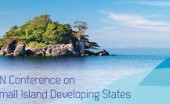
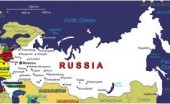


2 Comments on "Tibet"
Japan’s Emperor Akihito and other members of the royal family are unlikely to attend the Beijing Olympics amid concerns here about China’s crackdown in Tibet and other issues, a report said Wednesday.
The Japanese government thinks it is not a good time for a rare royal visit because of the unrest in Tibet, a recent health scare over Chinese-made “gyoza” dumplings and a spat over disputed gas fields, the Sankei daily said.
“We were planning not to ask royals to go even before the gyoza incident (surfaced in January). It is all the more true now that the Tibetan unrest occurred,” it quoted an unnamed government official as saying.
The last trip to China by members of Japan’s imperial household was a landmark visit by Emperor Akihito and Empress Michiko in 1992.
China remains deeply resentful over Japan’s brutal occupation from 1931 to 1945, an era in which the Japanese revered Akihito’s father Hirohito as a demigod.
The two countries have recently worked to mend ties, which were strained by former Japanese prime minister Junichiro Koizumi’s annual visits to a war shrine in Tokyo, which Beijing regards as a symbol of Japan’s militarist past.
The crackdown on religious dissidents in China in advance of the Olympics will be the topic of my show, News Talk Online on Paltalk.com Friday July 18 at 5 PM New York time.
Go to http://www.garybaumgarten.com and click on the link to join in the conversation. There is no charge.
Thanks